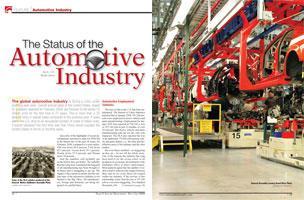
The global automotive industry is facing a crisis unlike anything ever seen. Overall annual sales in the 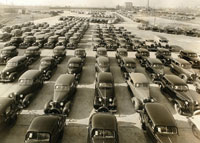 would surpass the
would surpass the
Just a few of the highlights of recent developments: automotive sales for 2008 fell at the fastest rate of the past 34 years; for February 2008, compared to a year earlier, GM was down 48.9 percent, Ford down 40.2 percent, Toyota down 39.1 percent, Honda down 33.5 percent, and Nissan down 54 percent.
And the numbers will probably get worse before they get better. The industry that has long been considered the king-pin of all manufacturing has been brought to its knees and is struggling to get up. The impact of the current economy and the current state of the automotive industry is not limited to the Big Three. All manufacturers, foreign and domestic, are being impacted on a global basis.
Automotive Employment Statistics
The loss of jobs in the
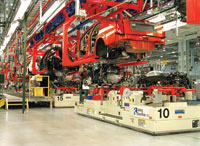 But even these numbers - as staggering as they are - do not tell the whole story. One of the reasons the industry has long been held to be the crown jewel of all prospects in economic development is the multiplier effect of direct employment. Most analysts agree that the number of indirect and/or induced jobs ranges between three and six for every direct job created within the industry. If the inverse of this relationship is true, then the loss of 197,100 jobs is even more staggering. Two hundred thousand jobs at a weighted average of $25 per hour working for a full year represent $10.4 billion in payroll.
But even these numbers - as staggering as they are - do not tell the whole story. One of the reasons the industry has long been held to be the crown jewel of all prospects in economic development is the multiplier effect of direct employment. Most analysts agree that the number of indirect and/or induced jobs ranges between three and six for every direct job created within the industry. If the inverse of this relationship is true, then the loss of 197,100 jobs is even more staggering. Two hundred thousand jobs at a weighted average of $25 per hour working for a full year represent $10.4 billion in payroll.
The automotive industry has become nearly stagnant in one of the shortest periods of time in history. Consumers are holding on to their current vehicles for more than a year longer than in recent years, and many are reluctant to buy new cars when their own job may be in jeopardy. An anomaly is that used cars are actually increasing in value compared to new cars which are decreasing in value.
The current state of the automotive industry has had a catastrophic impact on industry employees, automotive suppliers, automotive dealerships and consumers– not to mention its impact on the economic conditions of states, counties and communities. We have seen plant closures and job losses that stagger the imagination. We have seen state, county and city tax revenues tumble.
Targeted Predictions
But where is all of this headed? No one can predict the future. But we can make a critical analysis of current and past events. And we can make some fairly targeted predictions about the direction the automotive industry will take in the future:
1. Mergers, acquisitions and divestitures will dominate the landscape for the near term.
Over the past 15 years we have witnessed unprecedented acquisitions by General Motors, Ford and others, not only among each other and but also among automotive suppliers. Companies by the name of Jaguar, Land Rover, Saab and Volvo were bought, but retained product identity. Nissan was purchased by Renault. General Motors spun off
Just recently, Fiat announced they had obtained a 35 percent stake in Chrysler – and no upfront cash. It has just been reported by Der Spiegel in
Companies will continue to invest in each other, shed themselves of unprofitable operations and create new partnerships to address market opportunities.
2. The industry will continue consolidation and down-sizing for an additional 15 to 20 percent of current capacity.
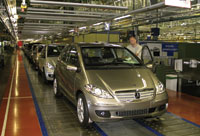 The automotive industry is oversized for the current economic and market conditions. While manufacturers have made a concerted effort to move their manufacturing facilities closer to their markets over the past 15 years, i.e. Mercedes Benz, BMW, Honda,
The automotive industry is oversized for the current economic and market conditions. While manufacturers have made a concerted effort to move their manufacturing facilities closer to their markets over the past 15 years, i.e. Mercedes Benz, BMW, Honda, All of the short-term efforts to reduce production levels are based on an optimistic view that sales are going to increase in the near term. And the current economic conditions and the state of the economy are trending toward the opposite. Excess capacity will have to be eliminated in order for the remaining production capacity to operate efficiently and at profitable levels.
3. Unions will become more cooperative with management in order to survive.
Great debates have been held on both sides of the spectrum about the impact of unions on competitiveness. Regardless of who is right or who is wrong, there must be compromises on both sides – labor and management – if the unionized sector of the automotive industry is to survive. It does not matter whether the unions are in the
4. Contract manufacturing and cross-product manufacturing will become more dominant in the future.
One of the unique characteristics within the automotive industry, unknown to many consumers, is the use of contract manufacturing. Under this practice, automotive companies contract with one another to manufacture vehicles. The vehicles typically use the same platform or chassis of
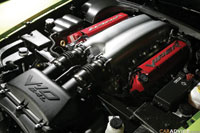 another model, but slightly different sheet metal and/or interior finishing. General Motors and
another model, but slightly different sheet metal and/or interior finishing. General Motors and MAGNA STEYR, a Magna International company, operates a plant in
Contract manufacturing provides reduced costs, probably reduced time-to-market, and greater flexibility for automotive manufacturers. Look for these strategies to be expanded in the future.
5. The next automotive assembly plant to be built in the Unites States will be built by a company from either
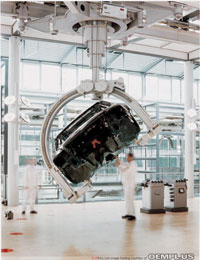 Automotive companies with assembly plants in
Automotive companies with assembly plants in Chinese automotive manufacturers have had their eye on the
Tata Group of
Automotive Industry – A Complex Operation
The automotive industry is one of the most complex operations in the world. The amount of time and energy required for product design and development, detailed engineering, supplier selection and integration, manufacturing planning and implementation, and product distribution is staggering. When one integrates these dimensions with manufacturing and assembly strategies, raw material and component sourcing, just-in-time and sequenced parts deliverables, lean manufacturing and best-in-class practices, as well as product quality and dependability expectations, the requirements within the automotive industry are almost too complex to comprehend. The efficient operation of even one automotive assembly plant is truly remarkable. The profitable operation of an entire corporation with multiple plants located in multiple countries in a global market and within a global economy is one of the greatest challenges faced by any private sector industry.
The Bottom Line
Dramatic changes in the global economy have driven the automotive industry to the brink of disaster. Consumer confidence has been stymied. Credit financing for both consumers and manufacturers has been tightened. Small to medium sized parts suppliers are finding it difficult, if not impossible, to stay in business.
There will be additional significant changes within the automotive industry over the next several months, many of which are predicted above. It is unfortunate, but most likely, that some automotive companies are not going to survive– at least not in their current size and configuration.
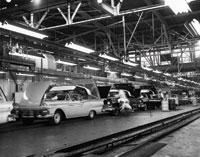 The total impact and the eventual outcomes are yet to be determined. There will undoubtedly be winners and losers. But in the end, the strong will prevail, and the industry will emerge with new dominant leaders. The industry will be smaller, leaner, and probably a lot more flexible than in the past. Growth of the industry will be much slower. Revenue growth, once profitability recovers, is more likely to be in single digits for the near term, and will probably not reach double digit growth for many years. Some of the name brand vehicles consumers have known for the past 30 or more years, such as Oldsmobile for General Motors, will disappear. But those that survive will be much better in quality and serviceability than any vehicles in the past.
The total impact and the eventual outcomes are yet to be determined. There will undoubtedly be winners and losers. But in the end, the strong will prevail, and the industry will emerge with new dominant leaders. The industry will be smaller, leaner, and probably a lot more flexible than in the past. Growth of the industry will be much slower. Revenue growth, once profitability recovers, is more likely to be in single digits for the near term, and will probably not reach double digit growth for many years. Some of the name brand vehicles consumers have known for the past 30 or more years, such as Oldsmobile for General Motors, will disappear. But those that survive will be much better in quality and serviceability than any vehicles in the past.
The silver lining for the industry is that the survivors will come out of this period of economic stress in a much stronger position than ever, and they will succeed on a much grander scale than their predecessors. In the tradition of the

